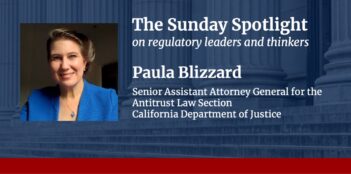
Scholars argue that antitrust law can be used to scrutinize state monopoly power and advance equality.
Edward Garrison Draper was an ideal candidate to practice law in Maryland. A top graduate of Dartmouth College at a time when most Maryland lawyers lacked a college degree, Draper apprenticed with respected attorneys and earned a certificate from a judge of the Baltimore Superior Court stating that he was “qualified in all respects to be admitted to the Bar in Maryland.” Nevertheless, the Maryland Bar rejected Draper’s 1857 application simply because he was Black.
Like so many others throughout United States history, Draper was a victim of obvious state-sanctioned racial discrimination. What may be less apparent, however, is that Draper was also a victim of state monopoly power.
In a forthcoming article in the Minnesota Law Review, Bennett Capers of Fordham Law School and Gregory Day from the University of Georgia outline the long history of states using their monopoly power to perpetuate economic inequality, especially along racial lines. According to Capers and Day, these discriminatory state monopolies have escaped antitrust scrutiny due to long-standing judicial misinterpretations of the 1890 Sherman Antitrust Act. Recovering the Sherman Act’s “neglected connection” to the egalitarian goals of Reconstruction, Capers and Day argue that the statute’s original purpose included challenging racially inequitable state monopolies. Antitrust law, they conclude, can and should be used as a tool to contest discriminatory state and local monopoly power.
State monopolies exist in many forms. For example, states often monopolize consumer markets by serving as the exclusive provider of a good or service, such as lottery tickets. Alternatively, they may entrust one business with monopoly power in a certain area, such as a utility company. States can also exercise monopoly power over the labor market by setting the licensing qualifications for certain professions, such as electricians, firefighters, and hairdressers. Through zoning ordinances and eminent domain, states even hold monopoly power over where people live and work.
For Capers and Day, not all these monopolies are problematic and many—such as public roads—are beneficial to the public. State monopoly power, they argue, becomes harmful when wielded in a discriminatory manner “to protect dominant interests and labor by restraining competition.” Under the guise of health and safety, for instance, state licensing agencies can block “outsiders”—disproportionately immigrants and people of color—from competing with legacy businesses in certain markets, including the food industry or cosmetology. Such practices, Capers and Day maintain, reduce economic mobility and reinforce the racial wealth gap.
The 1943 U.S. Supreme Court decision in Parker v. Brown shields state-sponsored anticompetitive actions from antitrust scrutiny. According to the Court, states enjoy this antitrust immunity because they lack the profit motive necessary to exploit monopolistic practices. And even if a state abuses its monopoly power, the people can hold it accountable through voting—without the help of antitrust.
Critiquing the Court’s reasoning, Capers and Day point out that states often do extract wealth through monopolistic practices, offering a strong motive to abuse this power. Likewise, Capers and Day also note that elections, due to their majoritarian nature, offer racial minorities a poor tool to redress discriminatory state monopolies.
But the “larger flaw” in the Parker decision, according to Capers and Day, is that it overlooks the connection between the Sherman Act and the Fourteenth Amendment—specifically, the amendment’s Privileges or Immunities Clause. Capers and Day contend that one of the original purposes of this clause was to prevent discriminatory state monopolies. In its 1873 decision in The Slaughter-House Cases, however, the Supreme Court upheld a Louisiana law granting an economic monopoly to a single slaughterhouse, ostensibly for public health. This ruling “eviscerated” the Privileges and Immunities Clause and narrowed the interpretation of the Fourteenth Amendment, preventing it, Capers and Day explain, from being used to combat discriminatory state monopolies.
Capers and Day argue that with the Privileges or Immunities Clause defunct, the drafters of the 1890 Sherman Act—including its namesake, Senator John Sherman (R-Oh.)—intended for the antitrust law to achieve “what the Fourteenth Amendment had failed to do.” These intentions included, in Senator Sherman’s words, preventing states from conferring “special grants to favored companies” and guaranteeing “that no private corporation shall be created with exclusive rights or privileges.”
In addition, Capers and Day claim that these lawmakers “intentionally settled on a deliberately broad Act.” They emphasize that this broadness allows for flexible interpretation which courts and enforcers could use to target state monopolistic practices that harm vulnerable communities. By leveraging antitrust law in this way, the Capers and Day suggest that the Sherman Act could help realize the unfulfilled promise of Reconstruction—economic opportunity and racial equality.



